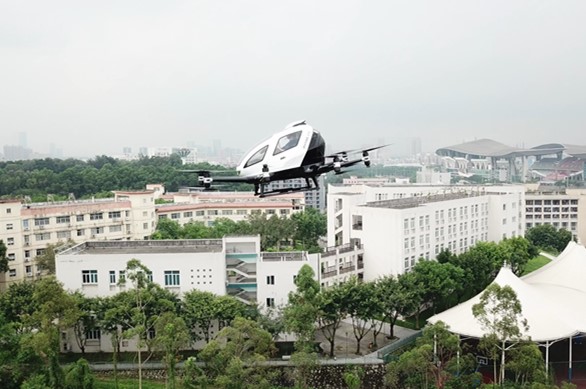
by Michael Willoughby
Urban air vehicles (UAVs) should be managed more like a bus network than a taxi system according to Chinese autonomous aerial vehicle (AAV) technology platform company, EHang.
“UAM will be safer, more effective, and more immediately deployable if it structurally resembles an on-demand bus system with centralized oversight and set point-to-point routes rather than a taxi system with diffuse routes,” the developer said in a press release.
The finding comes from a white paper on the future of transportation and urban air mobility (UAM). According to eHang, the paper explores UAM’s potential to transform transportation globally with insights into vehicle design, an overview of potential applications and the current regulatory landscape, and recommendations for how to optimize UAM’s path towards commercialization.
“UAM and the widespread use of passenger and cargo AAVs will transform how people and goods move around urban areas,” said Mr. Huazhi Hu, the Founder, Chairman, and Chief Executive Officer of EHang. “The successful deployment of AAVs will help cities improve efficiency, enhance safety, cut costs, and become more environmentally sustainable.”
Other insights from the white paper include:
- The success of UAM will depend on commercial operations that are centrally managed. This is a different model from the traditional airline industry in which hundreds of airlines globally compete with each other, leading to smaller margins.
- Key characteristics of a successful UAM system include: autonomous services (i.e. pilotless passenger and cargo transportation); point-to-point, straight-line, fixed air routes; a centralized command-and-control platform that manages all AAV flights within a certain area; a shared economy (i.e. no individual ownership of AAVs); and a reliance on green energy.
- In order to ensure that safety remains the top priority for vehicle design, AAVs need to include: power source redundancy (e.g. by having multiple motors and propellers); completely autonomous operations; back-up / duplicate flight control, communications, and navigation systems.
- Based on EHang’s modeling for future commercial operations, a straight-line trip on an AAV could be cheaper for the user than a current New York City taxi ride covering the same distance, all while still being profitable to the operator. Furthermore, the model used is highly conservative since it does not capture the efficiency gains of future economies of scale, improved battery technologies, etc.
- While the AAV conversation has mostly focused on urban spaces, there are broad non-urban applications for services currently being provided by helicopters, including in search and rescue, emergency medical services, offshore operations, oil and gas, firefighting, forestry, power-line repair and surveys, agriculture and pest control, media, aerial photography, and law enforcement.
- The successful development of a UAM ecosystem will require deep collaboration between UAM vehicle providers, UAM network operators, infrastructure developers, telecommunication network partners, city, regional and national governments, etc.
EHang is the first UAM company to commercialize its passenger-grade AAVs, having already delivered 38 units to customers as of December 5, 2019, and is actively working to make UAM an everyday reality in cities worldwide.
For more information
https://finance.yahoo.com/news/ehang-publishes-first-white-paper-120010394.html?from=groupmessage

